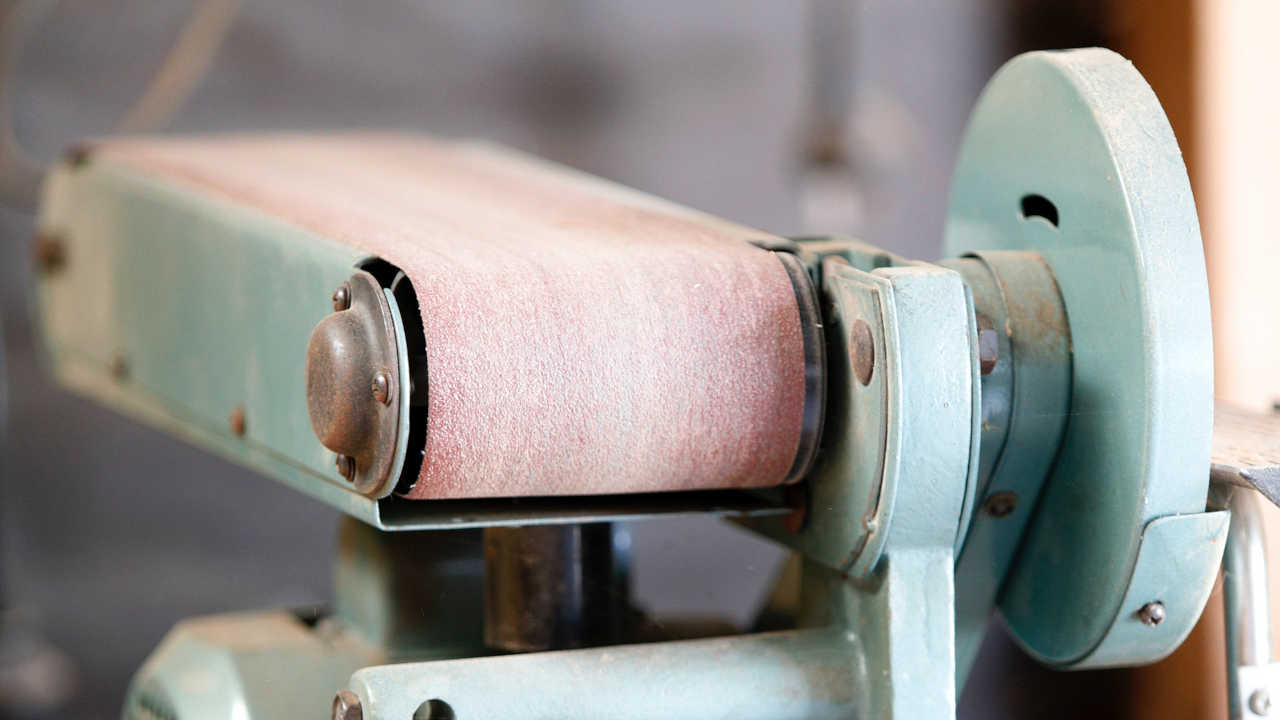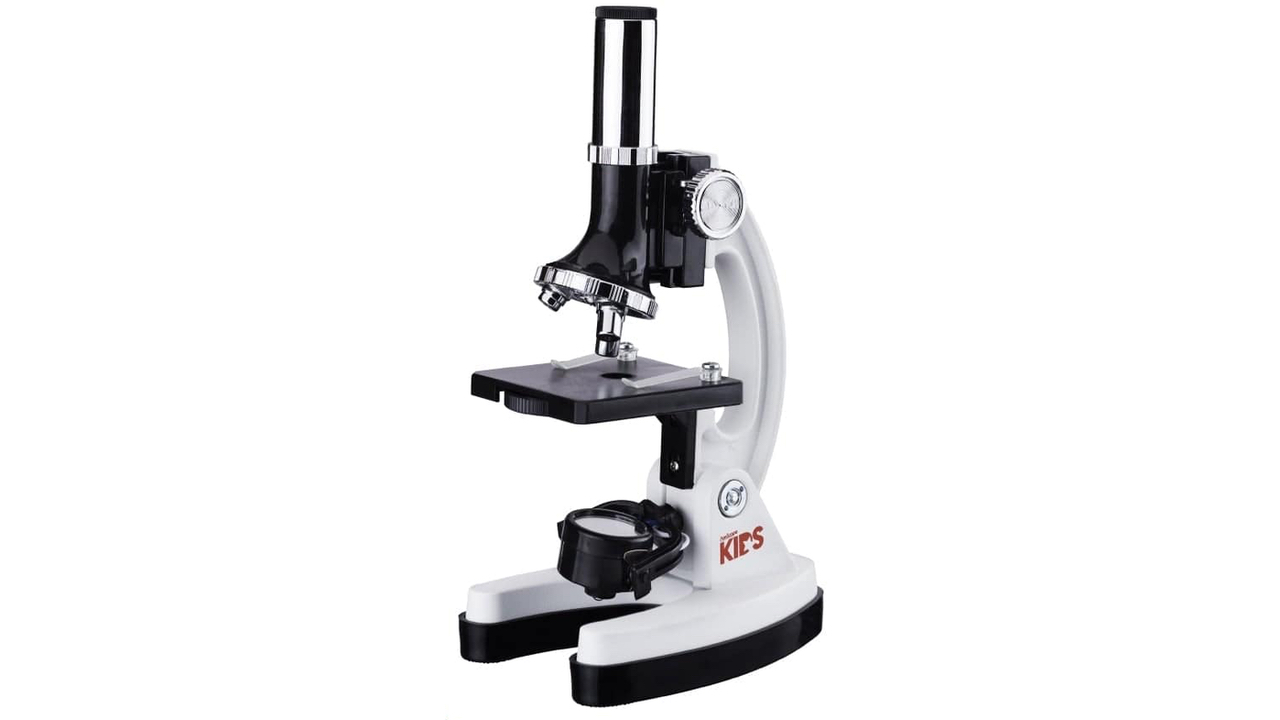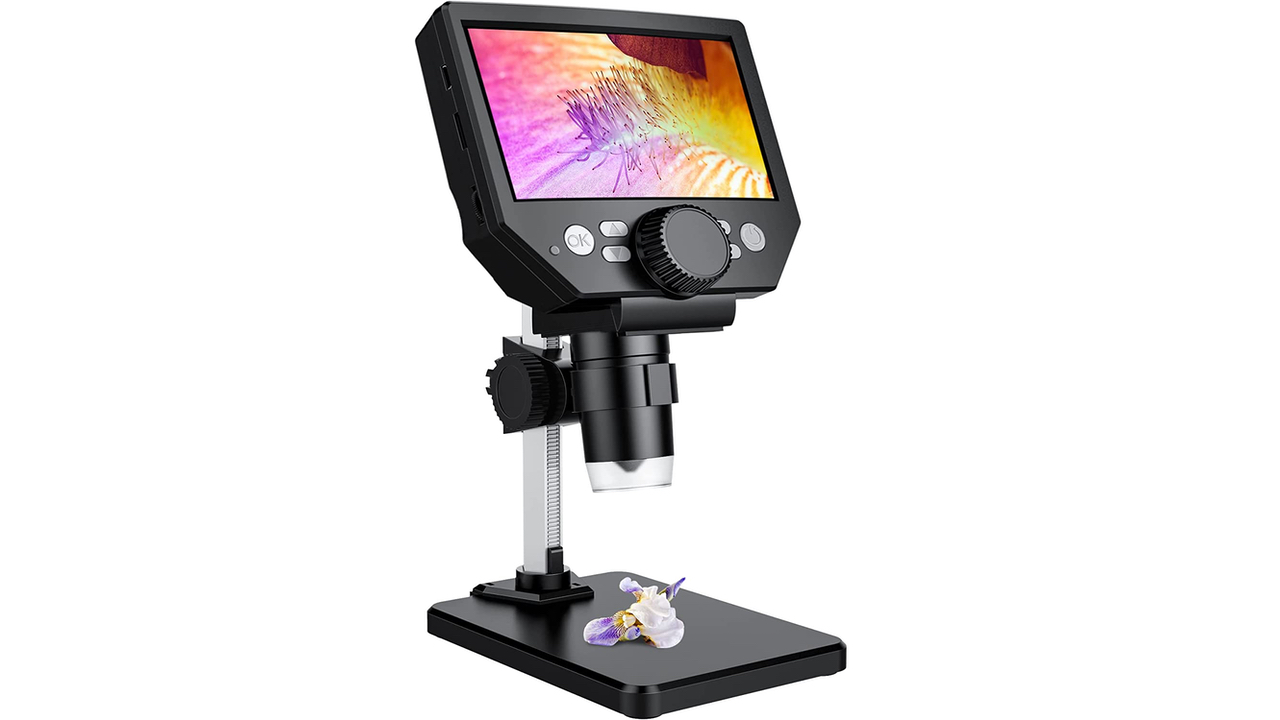The best belt sanders are powerful tools that have become indispensable in the lives of woodworkers, DIY enthusiasts, and craftsmen. With their ability to swiftly and efficiently smooth surfaces and remove material, belt sanders save time and effort, allowing individuals to achieve professional-quality results and unleash their creativity in various projects.
Best Overall | Bang For Your Buck | Best on a Budget | Best Handheld Belt Sander | Best Cordless Belt Sander |
|---|---|---|---|---|
WEN 6502T | Makita 9403 | Skil 7510-01 | Metabo HPT SB8V2 | DEWALT 20V MAX* |
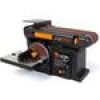 | 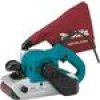 | 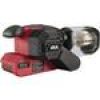 | 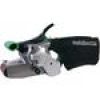 |  |
The WEN 6502T is a versatile belt sander with a two-in-one design, offering a 4-by-36-inch belt and a 6-by-6-inch disc, providing stability, convenient belt changes, and versatile sanding options for woodworking projects. | The Makita 9403 is a powerful and quiet belt sander designed for fast material removal, making it a top choice for woodworkers, carpenters, and contractors who prioritize performance and operator comfort. | The Skil 7510-01 is a budget-friendly belt sander equipped with pressure control technology and efficient dust collection, making it an excellent choice for DIYers and users seeking an affordable sanding tool with optimal finish results. | The Metabo HPT SB8V2 is a powerful handheld belt sander with variable speed control and excellent dust collection, ideal for a variety of sanding applications. | The DEWALT 20V MAX is a cordless belt sander offering exceptional portability, variable speed control, and efficient dust collection, making it perfect for versatile on-the-go sanding tasks. |
What Is a Belt Sander?
A belt sander is a power tool designed for sanding and smoothing surfaces using a continuous loop of sandpaper, or belt, wrapped around two drums. It operates by rotating the drums, which move the sandpaper belt in a linear motion. Belt sanders are known for their aggressive material removal capabilities, ideal for leveling uneven surfaces, removing paint or varnish, and shaping or smoothing wood, metal, and other materials. They come in many sizes and designs, offering different power levels, speed control, and additional features to suit specific sanding needs.
Why Buy a Belt Sander?
There are several compelling reasons why someone would choose to invest in a belt sander. Firstly, belt sanders excel at material removal, making them indispensable for tasks that involve leveling surfaces or removing layers of paint, varnish, or other coatings. Whether refurbishing furniture, restoring wooden floors, or preparing a surface for painting, a belt sander can save you lots of time and effort compared to manual sanding methods.
Secondly, belt sanders are highly efficient at smoothing and shaping various materials. Woodworkers and craftsmen rely on belt sanders to achieve precise and smooth finishes on their projects, whether creating beveled edges, chamfering, or rounding corners. The continuous motion of the sandpaper belt allows for consistent and even sanding, resulting in professional-quality outcomes.
Additionally, belt sanders offer versatility in terms of the materials they can work with. While commonly used on wood, they are also effective for sanding metal, plastic, and other materials, expanding their utility beyond traditional woodworking applications. This versatility makes belt sanders a valuable tool for professional tradespeople and DIY enthusiasts, allowing them to easily tackle a wide range of projects.
The main benefits of owning a belt sander are its efficiency, power, and versatility. A belt sander empowers individuals to achieve excellent results and complete their sanding tasks more quickly and effortlessly than manual methods by providing rapid material removal, precise smoothing, and the ability to work with different materials.
Belt Sanders: What to Look For
When considering the purchase of a belt sander, it’s crucial to evaluate various features to ensure you select the right tool for your needs. Here are ten critical criteria to consider:
Best Overall: WEN 6502T Belt/Disc Sander
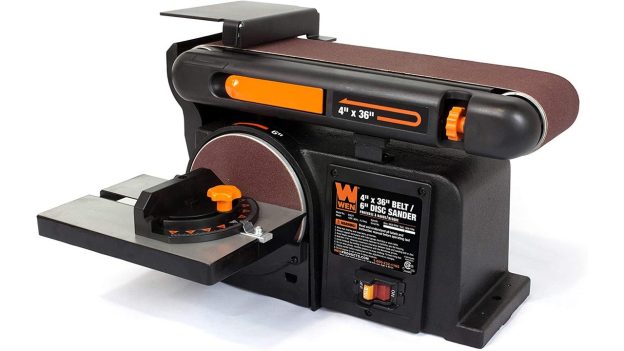
Image credit: WEN
Pros:
Cons:
The WEN 6502T is a versatile and reliable belt sander that stands out as the best option on the market today for several reasons.
First of all, it is a two-in-one sanding machine featuring a 4-by-36-inch belt and a 6-by-6-inch disc, providing users with a variety of sanding options for different workpieces. The belt can tilt anywhere from 0 to 90 degrees, allowing for flexible sanding angles and accommodating various project needs.
Additionally, the sander boasts a sturdy cast iron base that effectively prevents heavy vibrations, ensuring stability during operation. The 4.3 Amp motor delivers up to 3600 RPM, providing ample power to handle demanding sanding tasks without bogging down.
The tension release lever makes changing between sandpaper grits a simple and time-saving process, allowing for efficient workflow. Including a miter gauge, stop bar, and dust port further enhances the sander’s usability and safety features.
Backed by a two-year warranty, a nationwide network of skilled technicians, and excellent customer service, the WEN 6502T offers peace of mind and reliable support. With its impressive features, power, and versatility, it’s clear why the WEN 6502T stands out as the best belt sander choice in the market today.
Bang For Your Buck: Makita 9403 Belt Sander
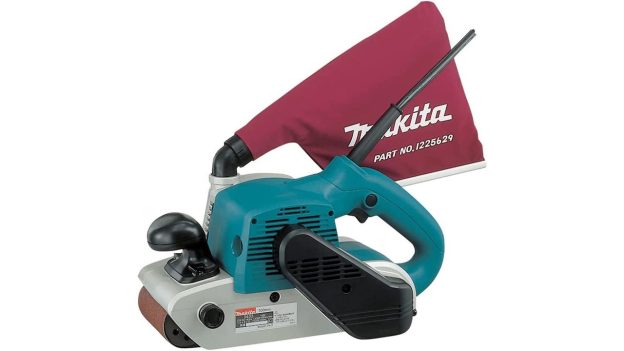
Image credit: Makita
Pros:
Cons:
The Makita 9403 Belt Sander is a strong and reliable tool that excels in speed, ease of use, and low noise levels, making it a top choice for professionals and woodworking enthusiasts alike. With its 4″ wide belt operating at a speed of 1,640 ft./min., the 9403 offers exceptional stock removal capabilities, allowing for efficient and precise material removal. This makes it ideal for sanding large surfaces, removing paint or varnish, and leveling uneven wood or other materials.
One standout feature of the Makita 9403 is its low noise operation, measuring at only 84 dB. This makes it one of the quietest belt sanders in its class, ensuring a more comfortable working environment and reducing noise-related fatigue during prolonged sanding sessions. The sander’s impressive noise control benefits those working in residential areas or noise-sensitive environments.
Regarding construction and durability, the 9403 is designed with labyrinth construction, effectively sealing the motor and bearings from dust and debris. This protective feature prolongs the tool’s lifespan and enhances its overall performance and reliability. Additionally, the sander features a large front grip positioned for operator comfort, providing a secure and comfortable grip during operation. The easy lever control makes belt changes quick and hassle-free, allowing seamless transitions between sandpaper grits without wasting valuable time.
Overall, the Makita 9403 Belt Sander offers exceptional power, speed, convenience, reduced noise levels, and durable construction. Whether you’re a professional woodworker, carpenter, furniture maker, or general contractor, the 9403 is a best-in-class belt sander that delivers impressive performance and reliable results.
Best on a Budget: Skil 7510-01
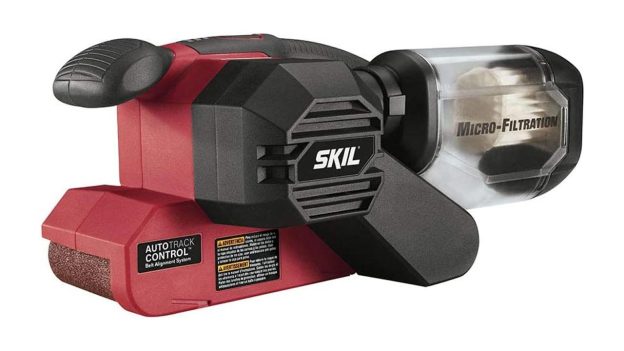
Image credit: Skil
Pros:
Cons:
The Skil 7510-01 Belt Sander is an excellent budget-friendly option with impressive features and performance. Its pressure control technology monitors the sanding pad pressure to ensure an optimal finish, making it ideal for achieving consistent results. The sander’s 6.0 A of power allows it to handle various wood surfaces effectively, providing versatility for sanding projects.
One standout feature of the Skil 7510-01 is its micro-filtration system, which captures and contains fine dust particles. This helps to keep the work area cleaner and provides a healthier environment by reducing airborne dust. Additionally, the sander is vacuum compatible and fits standard 1-1/4-inch vacuum hoses, further enhancing dust collection efficiency.
This budget belt sander also incorporates auto-track belt alignment, ensuring the belt stays centered on the sander during operation. This feature eliminates frequent adjustments, allowing for uninterrupted sanding and smoother results. Its compact and ergonomic design makes the sander portable and easy to maneuver.
The Skil 7510-01 Belt Sander is the best budget option due to its pressure control technology, powerful motor, effective dust collection, and convenient features like auto track belt alignment. It offers excellent value for money and is a reliable choice for DIY enthusiasts and woodworkers looking for an affordable belt sander without compromising performance.
Best Handheld Belt Sander: Metabo HPT SB8V2
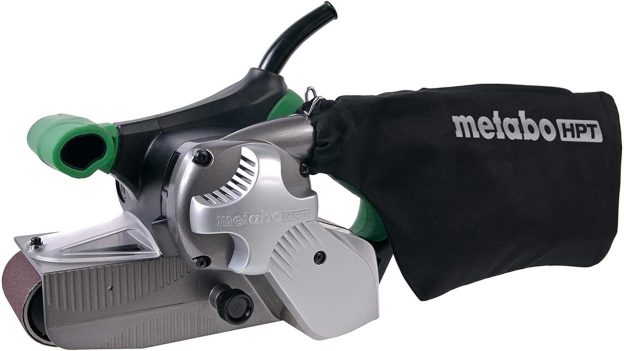
Pros:
Cons:
The Metabo HPT Belt Sander, also known as the SB8V2, is a top-notch handheld belt sander that excels in performance and versatility. A robust 9 amp 1,020-watt motor delivers forcible power to tackle even the most demanding sanding jobs. The variable speed control dial located at the base of the handle allows for precise speed adjustments, catering to various applications and enhancing manageability.
One of the standout features of the Metabo HPT Belt Sander is its clear front cover, which significantly improves visibility while sanding against surfaces. This ensures accurate and efficient sanding results. Additionally, the left-side mounted dust collection bag and the option to attach a vacuum swivel attachment contribute to excellent dust collection capabilities, keeping the work area clean and reducing airborne particles.
The SB8V2’s design is optimized for quick and even sanding with its flush surface design. It comes with a professional 5-year limited warranty, assuring users of its durability and reliability. Whether sanding wooden or metallic surfaces, finishing flooring, preparing surfaces for painting, or tackling masonry materials like slate and concrete, the Metabo HPT Belt Sander provides exceptional performance for a wide range of applications.
Best Cordless Belt Sanders: DEWALT 20V MAX*
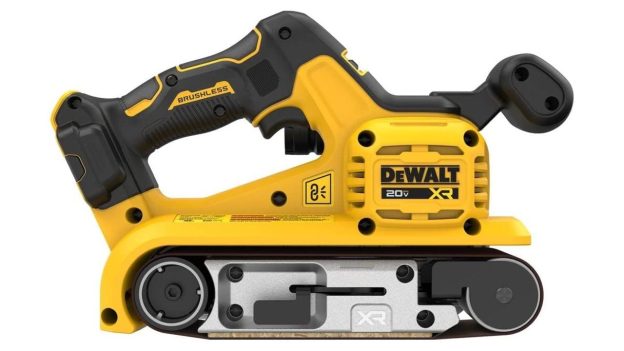
Image credit: DEWALT
Pros:
Cons:
The DEWALT 20V MAX* Belt Sander is a cordless power tool designed with the professional in mind, making it the best cordless belt sander available. It offers several features that enhance its performance and usability. The variable speed trigger with lock-on and speed selection dial provides ultimate speed and application control, with 25 speed increments for precise adjustments. The quick-release belt change system allows for easy and efficient sandpaper replacement.
One of the standout features is the over-mold auxiliary handle, which enables two-handed operation and provides a better grip, especially for scribing applications. The dust collection system is highly effective, with a tool-free dust chute compatible with DEWALT’s Airlock System or a standard 35mm dust extractor, ensuring minimal dust during sanding.
Additionally, the wireless tool control system allows for seamless integration with compatible DEWALT vacuums or dust extractors, further enhancing convenience and ease of use. With a brushless motor, the sander offers increased runtime and efficiency, while the 3×21-inch platen allows for larger surface area sanding.
The DEWALT 20V MAX* Belt Sander combines power, versatility, and user-friendly features, making it the top choice for professionals in carpentry, remodeling, and general contracting who require a cordless belt sander that delivers exceptional performance.
What is a belt sander used for?
Belt sanders are primarily used for smoothing and shaping wood surfaces. These powerful tools can quickly remove material, making them ideal for tasks that require leveling uneven surfaces or removing old paint and varnish. The continuous loop of sandpaper moves in a linear motion, which provides a consistent and even sanding action. Woodworkers use belt sanders for tasks like creating beveled edges, chamfering, and rounding corners, as well as for preparing large wooden surfaces before finishing.
In addition to woodworking, belt sanders can be used on other materials such as metal and plastic. For example, they can smooth welds, remove rust, or prepare surfaces for painting and finishing in metalworking projects. They are also useful for working on plastic materials, helping to shape and smooth them as needed. The versatility of belt sanders makes them valuable tools in a variety of trades and DIY projects, offering a quick and efficient way to achieve professional results.
What are the different types of belt sanders?
Handheld belt sanders are portable and versatile, making them suitable for a wide range of tasks. They are commonly used for smaller projects where mobility is essential, such as sanding table edges, doors, or cabinets. Handheld models come in various sizes and power levels, allowing users to select the right tool for the job. They are especially useful for working on vertical surfaces or in tight spaces where a stationary sander would be impractical.
Stationary belt sanders, on the other hand, are larger and more powerful, designed for heavy-duty sanding tasks. These machines are mounted on a workbench or stand and are ideal for larger projects that require significant material removal or precision sanding. Stationary belt sanders often come with additional features such as adjustable tables, miter gauges, and dust collection systems. They are typically used in professional workshops and for industrial applications, providing stability and consistency for demanding projects.
How do I choose the right belt sander for my project?
When selecting a belt sander, consider the size and type of your project. For small, detailed work or projects requiring a portable tool, a handheld belt sander is a great choice. Look for a model with ergonomic handles and variable speed control for better precision and comfort during extended use. Consider the power of the motor and the size of the belt, as these factors will influence the tool’s effectiveness and versatility for different tasks.
For larger surfaces or more intensive sanding needs, a stationary belt sander is often more suitable. These models offer greater power and stability, making them ideal for tasks such as flattening large wooden panels, shaping metal parts, or working on extensive renovation projects. Evaluate the features of the stationary sander, such as the belt size, ease of belt changes, and the quality of the dust collection system. Choosing the right belt sander depends on balancing the specific requirements of your project with the capabilities and features of the tool.
What safety precautions should I take when using a belt sander?
Always wear safety goggles and a dust mask to protect your eyes and respiratory system from dust and debris. Belt sanders can generate a significant amount of dust and small particles that can be harmful if inhaled or if they come into contact with your eyes. Additionally, wearing ear protection is recommended, as these tools can be quite noisy, especially during prolonged use. Make sure to tie back long hair and avoid wearing loose clothing or jewelry that could get caught in the moving parts of the sander.
Ensure that the workpiece is securely clamped down before starting the sander to prevent it from moving or shifting during operation. Keep your hands away from the moving belt and use both hands to hold and guide the sander for better control and stability. Follow the manufacturer’s instructions and safety guidelines for your specific model, including the proper maintenance and storage of the tool. By taking these precautions, you can minimize the risk of accidents and ensure a safer working environment.
How do I maintain my belt sander?
Regular maintenance of your belt sander is essential for its longevity and performance. Start by keeping the dust collection system clean and free of clogs. Empty the dust bag or container frequently to prevent dust buildup, which can hinder the tool’s performance and potentially cause overheating. Use compressed air to blow out dust from the motor and other components, and wipe down the exterior surfaces with a clean cloth to remove any dust or debris.
Check the sandpaper belt regularly for wear and replace it when it becomes worn out or damaged. Ensure the belt is properly aligned and tracks correctly on the drums to avoid uneven sanding and potential damage to the sander. Lubricate moving parts as recommended by the manufacturer to keep the tool running smoothly. By performing these maintenance tasks regularly, you can ensure that your belt sander operates efficiently and remains in good working condition for years to come.
Can I use a belt sander on metal?
Yes, belt sanders can be used on metal surfaces, making them versatile tools for various applications. When sanding metal, it is important to use the appropriate type of sandpaper, typically aluminum oxide or zirconia belts, which are designed for metalworking. These belts are more durable and can handle the heat generated from sanding metal. Belt sanders are effective for tasks such as removing rust, smoothing welds, and preparing metal surfaces for painting or finishing.
However, sanding metal can generate sparks, so it’s crucial to take necessary fire safety precautions. Ensure your workspace is free of flammable materials and have a fire extinguisher nearby. Wear appropriate safety gear, including gloves, to protect your hands from sharp metal edges and hot surfaces. By following these guidelines, you can safely and effectively use your belt sander for metalworking projects.
What is variable speed control, and why is it important?
Variable speed control is a feature that allows you to adjust the speed at which the sanding belt moves. This is important because different materials and sanding tasks require different speeds for optimal results. Higher speeds are ideal for rapid material removal and rough sanding, while lower speeds are better suited for fine finishing and working on delicate materials. With variable speed control, you can match the tool’s performance to the specific needs of your project, enhancing both efficiency and precision.
This feature is particularly useful when working on diverse projects or with various materials. For example, when sanding hardwood, you might need a slower speed to avoid burning the wood, whereas a higher speed might be necessary for removing paint from metal. Having the ability to adjust the speed gives you greater control over the sanding process, allowing you to achieve better results and extend the life of your sandpaper belts by reducing unnecessary wear and tear.
How do I change the sandpaper belt on my sander?
Changing the sandpaper belt on your belt sander is usually a straightforward process. Most belt sanders are equipped with a tension release lever or knob that loosens the belt, allowing you to easily remove the old one. Before you start, make sure the sander is unplugged or the battery is removed for safety. Once the tension is released, slide the old belt off the drums, and inspect the new belt to ensure it is the correct size and type for your sander.
Position the new belt on the sander, ensuring the arrows on the inside of the belt match the direction of rotation indicated on the sander. Tighten the tension lever or knob to secure the new belt in place. Turn on the sander and let it run for a few seconds to check the belt tracking. If necessary, adjust the tracking control to center the belt on the drums. Properly changing and aligning the sandpaper belt ensures effective sanding and prolongs the life of both the belt and the sander.
Why is dust collection important in a belt sander?
Effective dust collection is crucial for maintaining a clean and safe working environment. Belt sanders can produce a significant amount of dust, which can obscure your view, contaminate the workspace, and pose health risks if inhaled. A good dust collection system captures the dust at the source, reducing airborne particles and keeping your workspace cleaner. This not only improves visibility and precision during sanding but also minimizes the need for extensive cleanup after your project.
Additionally, proper dust collection helps protect the internal components of the sander from dust buildup, which can cause overheating and reduce the tool’s lifespan. Regularly emptying the dust bag or container and ensuring the dust collection system is functioning correctly will enhance the overall performance and durability of your sander. By investing in a belt sander with an efficient dust collection system, you can work more safely and maintain the tool’s effectiveness over time.
What should I do if my belt sander is not tracking properly?
If your belt sander’s belt is not tracking correctly, the first step is to check the tracking control mechanism. Most belt sanders have an adjustment knob or lever that helps align the belt on the drums. Turn the adjustment knob slowly while the sander is running to center the belt. Make small adjustments and check the belt position frequently until it is properly aligned. Proper tracking ensures even sanding and prevents the belt from slipping off during operation.
If adjusting the tracking control does not resolve the issue, inspect the belt for wear or damage. Worn-out or damaged belts can cause tracking problems and should be replaced. Additionally, check the condition of the drums and ensure they are clean and free of debris. Any buildup or damage on the drums can affect belt alignment. Regular maintenance and proper handling of the sandpaper belt can prevent tracking issues and ensure smooth and efficient operation of your belt sander.

